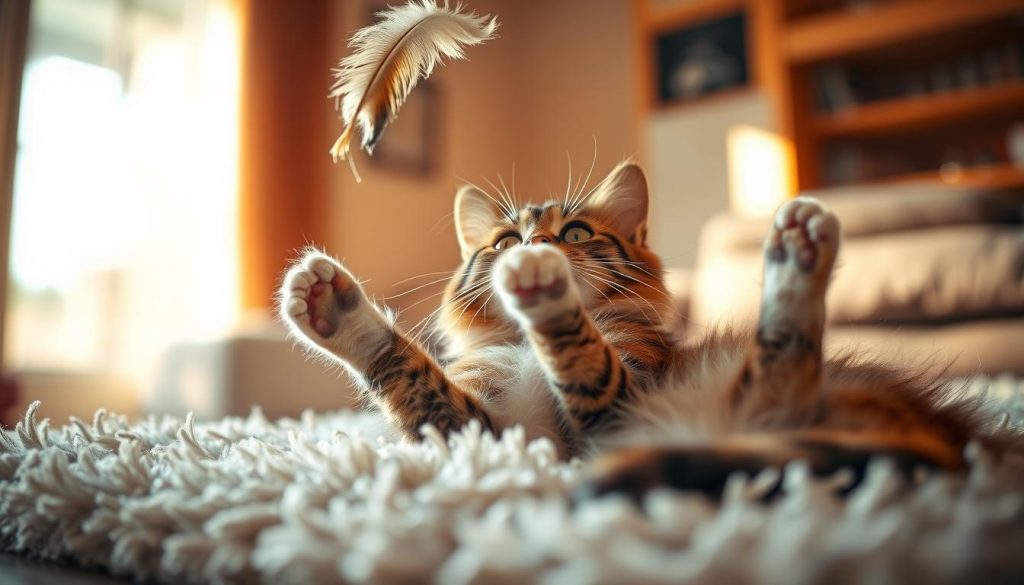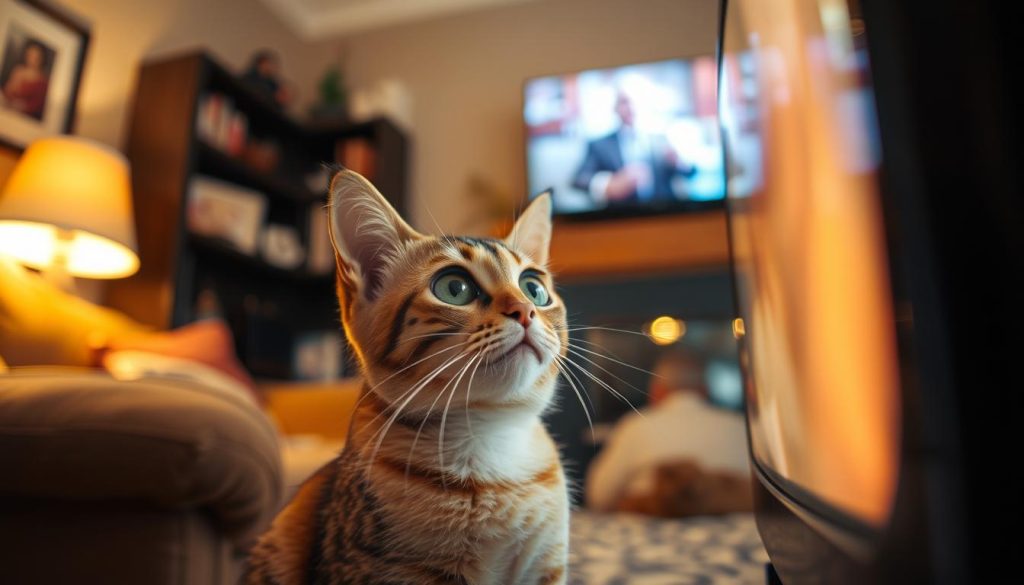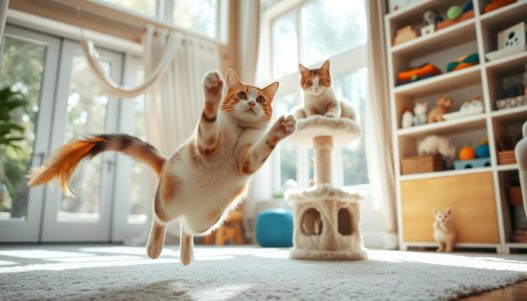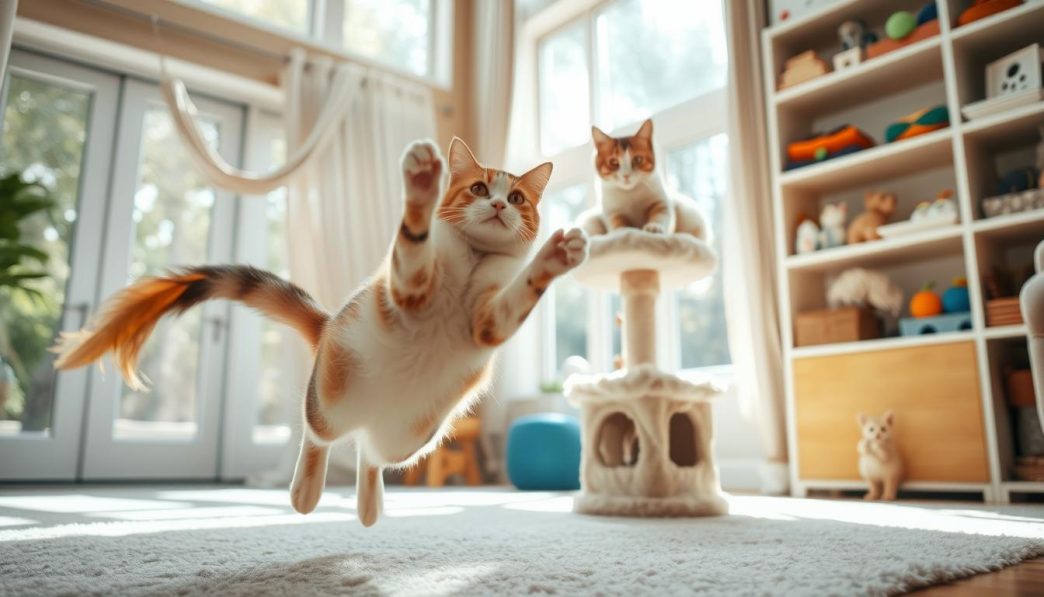Indoor cats often lead sedentary lives, which can negatively impact their overall well-being. Providing mental stimulation is crucial to keep them engaged and active. Engaging in various activities can help reduce boredom, stress, and obesity in cats.
Cat owners can benefit from incorporating interactive games and puzzle toys into their cat’s daily routine. These activities challenge and engage their cat’s mind, promoting a healthier and happier life. In this article, we will explore various mental stimulation activities suitable for indoor cats.
Key Takeaways
- Interactive games can help reduce boredom and stress in indoor cats.
- Puzzle toys provide mental stimulation and challenge.
- Engaging in activities can promote a healthier and happier life for cats.
- Cat owners can benefit from incorporating games into their cat’s daily routine.
- Mental stimulation is crucial for indoor cats’ overall well-being.
The Importance of Mental Exercise for Indoor Cats
Indoor cats benefit significantly from mental exercise, which helps mitigate behavioral problems. Cats are natural predators with innate hunting instincts that need to be stimulated to keep them engaged and active.
Natural Hunting Instincts in Confined Spaces
Indoor cats often lack the opportunity to express their natural hunting instincts, leading to pent-up energy and frustration. Providing cat enrichment activities can help simulate the hunting experience, keeping them mentally stimulated. Interactive toys that mimic prey can encourage natural behavior.
Preventing Boredom-Related Behavioral Problems
Boredom can lead to a range of behavioral issues in indoor cats, including scratching furniture, excessive meowing, and even depression. Engaging your cat with interactive cat toys can prevent these problems by keeping their mind occupied. Regular mental stimulation can redirect their energy into more positive behaviors.
Physical and Mental Health Benefits
Mental exercise is not just beneficial for a cat’s mental health; it also has physical health benefits. Engaging in play and problem-solving activities can help maintain a healthy weight and improve overall physical fitness. Moreover, mental stimulation can reduce stress and anxiety, contributing to a longer and healthier life.
By incorporating cat enrichment activities and interactive cat toys into your cat’s daily routine, you can significantly enhance their quality of life. This proactive approach to mental stimulation can lead to a happier, healthier indoor cat.
Recognizing Signs Your Cat Needs More Mental Stimulation
Understanding the indicators of insufficient mental stimulation can help cat owners take corrective action. Cats require mental stimulation to stay healthy and happy, and a lack of it can manifest in various ways.
Destructive Behaviors and Their Meaning
Destructive behaviors such as scratching furniture or knocking over objects can be a sign that your cat is not getting enough mental stimulation. These actions are often a result of excess energy and boredom. Redirecting this energy into more productive activities can help alleviate the problem. For instance, providing puzzle toys or engaging in play can channel their energy positively.
Excessive Sleeping or Lethargy
While cats are known to sleep a lot, excessive sleeping or lethargy can be an indicator of boredom or lack of mental stimulation. Cats need to be engaged and challenged to stay active and healthy. If your cat is sleeping more than usual, it might be time to introduce new toys or activities to keep them stimulated.
Overgrooming and Stress Indicators
Overgrooming is another sign that your cat may be experiencing stress or boredom. This behavior can lead to hair loss and skin irritation. Providing a variety of toys and activities can help reduce stress and prevent overgrooming. As noted by cat behaviorists, “Cats groom for relaxation, but excessive grooming can be a sign of anxiety or boredom.” Ensuring your cat has enough mental and physical stimulation is crucial.
By recognizing these signs and taking appropriate action, cat owners can help ensure their pets lead happier, healthier lives. Engaging your cat in various activities and providing mental stimulation can prevent boredom-related issues.
Understanding Your Cat’s Play Preferences
Recognizing your cat’s play preferences can significantly enhance their mental and physical well-being. Cats are individuals, much like humans, and their preferences for play can vary widely.
Cats generally fall into several categories based on their play preferences. Understanding these categories can help you tailor your approach to your cat’s unique needs.
The Hunter: High-Energy Chasers
Some cats are natural-born hunters, always on the lookout for their next prey. These high-energy chasers require toys and activities that mimic hunting, such as feather wands or laser pointers. Engaging these cats in play not only burns energy but also satisfies their instinctual behaviors.
The Thinker: Problem-Solving Cats
Other cats are more cerebral, enjoying activities that challenge their problem-solving skills. Interactive cat toys, such as puzzle feeders, are ideal for these cats. They require cats to figure out how to get a treat, keeping their minds active and engaged.
The Observer: Window-Watching Enthusiasts
Some cats are content to simply observe their surroundings, often enjoying window-watching. Providing a bird-watching station or a cat shelf near a window can be a great way to engage these cats, offering them a stimulating view and a comfortable perch.
| Cat Type | Preferred Activities | Benefit |
|---|---|---|
| The Hunter | Feather wands, Laser pointers | Burns energy, satisfies hunting instinct |
| The Thinker | Interactive puzzle feeders | Engages problem-solving skills |
| The Observer | Window-watching, Cat shelves | Provides mental stimulation, comfort |

By understanding and catering to your cat’s play preferences, you can significantly enhance their quality of life. Whether your cat is a hunter, a thinker, or an observer, there’s a wealth of options available to keep them engaged and happy.
Mental Stimulation Games for Indoor Cats: Food Puzzles and Foraging
Food puzzles and foraging are excellent ways to provide mental stimulation for indoor cats. These activities challenge your cat’s natural hunting instincts, keeping them engaged and active. By incorporating food puzzles and foraging into your cat’s daily routine, you can help prevent boredom and related behavioral issues.
Commercial Puzzle Feeders Worth Trying
There are numerous commercial puzzle feeders available that cater to different skill levels and preferences. These puzzle feeders are designed to challenge your cat and provide mental stimulation.
Beginner-Friendly Options
For cats new to puzzle feeders, it’s essential to start with simple designs. Brands like Outward Hound and PetSafe offer beginner-friendly puzzle feeders that are easy to use and clean. These puzzles typically require your cat to perform a simple action, like sliding a door or pawing at a lever, to access the food.
Advanced Challenges for Smart Cats
For more experienced cats, or those that quickly figure out simple puzzles, there are more complex designs available. Brands such as Tricky Treat Ball and Nina Ottosson offer challenging puzzles that require problem-solving skills to access the treats. These advanced puzzles keep your cat engaged for longer periods, providing sustained mental stimulation.
| Puzzle Feeder | Difficulty Level | Features |
|---|---|---|
| Outward Hound Brick Puzzle | Easy | Simple design, easy to clean |
| Tricky Treat Ball | Medium | Adjustable difficulty, durable |
| Nina Ottosson Dog Brick | Hard | Complex problem-solving, hide-and-seek design |
DIY Food Games That Cost Almost Nothing
If you’re looking for a budget-friendly alternative, creating your own DIY food puzzles can be a fun and cost-effective way to provide mental stimulation for your cat. Simple items like cardboard boxes and plastic bottles can be turned into engaging puzzles.
For example, you can create a simple puzzle by cutting holes of varying sizes in a cardboard box. Fill the box with your cat’s favorite treats or kibble, and let them figure out how to get them out. Another idea is to use a plastic bottle with holes drilled into it; fill it with treats, and as your cat rolls the bottle around, the treats will dispense.
“The key to keeping your cat engaged is to rotate the puzzles and games regularly, ensuring they don’t become too familiar with any one activity.”
Incorporating Foraging Into Daily Routines
Incorporating foraging activities into your cat’s daily routine can be straightforward. Start by replacing one or two meals with puzzle feeders or foraging games. Gradually increase the difficulty level as your cat becomes more adept at figuring out the puzzles.
Foraging can also be encouraged by hiding your cat’s food or treats around the house, encouraging them to search and hunt. This activity not only provides mental stimulation but also promotes physical exercise.
Interactive Toys That Trigger Hunting Instincts
To keep your indoor cat entertained and stimulated, it’s essential to tap into their natural hunting instincts with the right toys. “Cats are born hunters,” as many experts say, and providing them with interactive toys can significantly enhance their mental and physical health.
Wand Toys and Proper Play Techniques
Wand toys are an excellent way to engage your cat’s hunting instincts. These toys usually consist of a flexible rod with a lure attached to the end, allowing you to mimic the movements of prey. Proper play technique involves swift, unpredictable movements, encouraging your cat to pounce and chase. This not only provides exercise but also satisfies their natural hunting behavior.
Electronic Motion Toys That Captivate Cats
Electronic motion toys are another effective way to stimulate your cat’s hunting instincts. These toys can move on their own, often in unpredictable patterns, enticing your cat to chase. Some models even allow you to control the movement remotely, adding an extra layer of interaction. Such toys are particularly useful for cats that get bored with traditional toys quickly.
Hide and Seek Games With Toys and Treats
Hide and seek games are a great way to engage your cat’s hunting instincts while also providing mental stimulation. By hiding toys or treats around the house, you encourage your cat to search and hunt. This activity not only exercises their body but also their mind, reducing the likelihood of boredom-related issues.
Laser Pointers: Best Practices and Precautions
Laser pointers can be a fun way to engage your cat’s hunting instincts, but they must be used with caution. Avoid shining the laser directly into your cat’s eyes, and ensure that the “red dot” is not too elusive, allowing your cat to occasionally “catch” it. This helps prevent frustration and ensures a positive play experience.
By incorporating these interactive toys into your cat’s play routine, you can significantly enhance their quality of life. As
“Play is the highest form of research” for cats, and it’s through play that they learn, adapt, and thrive.
Ensuring a variety of toys and play techniques will keep your cat engaged, active, and happy.
Sensory Enrichment Activities for Indoor Environments
Sensory enrichment is crucial for indoor cats to keep them engaged and stimulated. By catering to their senses, cat owners can create a more fulfilling environment that mimics the outdoors.
Visual Stimulation: Cat TV and Window Entertainment
Visual stimulation is a key aspect of sensory enrichment. Cat TV and window perches offer entertainment by showcasing birds, squirrels, and other wildlife. These visual stimuli can captivate cats for extended periods, providing mental stimulation.

Scent Games With Catnip, Silver Vine, and Valerian
Scent games are another effective way to enrich a cat’s environment. Catnip, Silver Vine, and Valerian are herbs known to stimulate cats’ senses. Hiding these scents around the house or using them in toys can encourage natural hunting behaviors.
| Herb | Effect on Cats | Usage |
|---|---|---|
| Catnip | Stimulates rolling and rubbing | Toys, scratching pads |
| Silver Vine | Encourages playful behavior | Toys, mats |
| Valerian | Promotes relaxation and attraction | Toys, bedding |
Tactile Exploration: Texture Boxes and Tunnels
Tactile exploration is vital for cats, allowing them to engage their sense of touch. Texture boxes filled with different materials like sand, rice, or beans, and tunnels made of various fabrics, provide cats with a variety of sensations to explore.
Auditory Stimulation: Sound Games for Cats
Auditory stimulation can be achieved through sound games. Using toys that make noise or playing cat-friendly music can capture a cat’s attention. This form of stimulation can be particularly engaging when combined with other sensory activities.
Training Games to Build Your Cat’s Cognitive Skills
Building your cat’s cognitive skills through training games can be a rewarding experience for both you and your pet. Cats are naturally curious creatures, and engaging them in mentally stimulating activities can significantly enhance their problem-solving abilities and overall well-being.
Clicker Training Fundamentals for Beginners
Clicker training is a highly effective method for teaching cats new behaviors. It involves using a small device that makes a clicking sound to mark desired actions, followed by a reward. This technique helps your cat associate the sound with positive behavior, making the learning process faster and more enjoyable.
To start clicker training, you’ll need a clicker and some treats. Begin by associating the clicker sound with the treats, then gradually introduce simple commands or actions. Be patient and consistent, as this method requires time and positive reinforcement.
Simple Tricks Every Cat Can Learn
Teaching your cat simple tricks is not only fun but also mentally stimulating. Tricks like “sit,” “stay,” and “shake” can be learned using positive reinforcement techniques. Start with one trick at a time, using treats and praise to encourage your cat.
“The key to successful cat training is patience and positive reinforcement. With consistent practice, your cat can learn a variety of fun and useful tricks.” – Certified Animal Trainer
Target Training and Obstacle Courses
Target training involves teaching your cat to touch a specific object, like a stick or ball, which can then be used to guide them through obstacle courses. This type of training challenges your cat’s problem-solving skills and provides physical exercise.
Setting up an obstacle course using household items can be a fun way to engage your cat’s natural hunting instincts. Guide your cat through the course using treats and encouragement, gradually increasing the difficulty level as they become more confident.
| Training Method | Description | Benefits |
|---|---|---|
| Clicker Training | Using a clicker to mark desired behaviors | Effective for teaching new behaviors, enhances communication |
| Target Training | Teaching cats to touch a specific object | Improves problem-solving skills, guides through obstacle courses |
| Treat-Finding Games | Hiding treats to encourage searching | Enhances memory, encourages natural foraging behavior |
Treat-Finding Games and Memory Challenges
Treat-finding games are an excellent way to challenge your cat’s memory and encourage natural foraging behavior. Hide treats around the house or in puzzle toys to stimulate your cat’s sense of smell and problem-solving skills.
As your cat becomes more adept at finding treats, you can increase the difficulty by hiding them in harder-to-reach places or using more complex puzzle toys. This will keep them engaged and mentally stimulated.
Creating a Rotating Enrichment Schedule
Cats thrive on novelty, making a rotating enrichment schedule an essential tool for indoor cat owners. By regularly changing the toys and activities available to your cat, you can keep their environment fresh and engaging.
Preventing Toy Fatigue Through Novelty
Toy fatigue occurs when cats become bored with the same toys, leading to a decrease in engagement. To prevent this, it’s essential to rotate toys regularly. Introduce new toys or reintroduce old ones after a break to keep things interesting. This can be done on a weekly or bi-weekly basis, depending on your cat’s level of engagement.
Seasonal Enrichment Ideas
Incorporating seasonal themes into your enrichment schedule can add variety and excitement. For example, during winter, you can create snow-themed sensory experiences using cold textures or winter scents. In summer, you can introduce sunlight-related play using reflective surfaces or laser pointers that mimic sunbeams.
| Season | Enrichment Ideas |
|---|---|
| Spring | Hide treats among fake flowers or use feather toys to mimic birds. |
| Summer | Use laser pointers to create sunbeam effects or provide cooling mats for sensory relief. |
| Autumn | Introduce crinkly leaves or hide treats among fall-themed toys. |
| Winter | Create snowball fights with crumpled paper or use cold textures for sensory play. |
Balancing Independent Play and Interactive Sessions
A balanced enrichment schedule includes both independent play and interactive sessions with your cat. Independent play allows your cat to engage with toys on their own, while interactive play strengthens your bond and provides exercise. Aim for a mix of both throughout the day to keep your cat engaged and happy.
Conclusion: Enriching Your Indoor Cat’s Life Through Play
Providing mental stimulation for indoor cats is crucial for their overall well-being and happiness. By incorporating a variety of engaging activities, cat owners can help prevent boredom-related behavioral problems and promote a healthier lifestyle.
Throughout this article, we’ve explored different ways to challenge and engage your cat’s mind, from food puzzles and interactive toys to sensory enrichment activities and training games. By rotating these activities and introducing new ones, you can keep your cat’s environment fresh and exciting.
The key to indoor cat happiness lies in understanding their individual preferences and needs. By recognizing signs of boredom and implementing strategies to address them, you can significantly improve your cat’s quality of life. Mental stimulation is not just a want, but a necessity for indoor cats.
By making a few simple changes to your cat’s daily routine, you can help ensure they lead a happy, healthy, and fulfilling life. Start exploring these mental stimulation games and activities today to enrich your indoor cat’s life through play.






